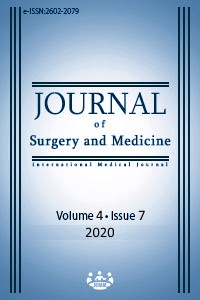Factors influencing malnutrition risk in hospitalized pediatric patients and the application of STRONGkids scoring
Keywords:
Child, Malnutrition, STRONGkids, Gomez, WaterlowAbstract
Aim: A significant factor affecting the response to treatment in children is malnutrition. To reduce its risk and morbidity, necessary precautions should be taken on the first day of hospitalization. It is highly essential to obtain clues that assist with the early detection of malnutrition at the time of hospitalization. In this study, we aimed to show the risk factors, body measurements and the importance of a scoring system in its early detection and evaluation. To this end, we examined the accuracy of the STRONGkids score, which is a simple, useful, and practical scoring system, in detecting the risk of malnutrition.
Methods: Children between 0-18 years of age without any chronic diseases who were hospitalized due to acute infection were included in this retrospective cohort study. Those with chronic illnesses were left out of scope of our research. The duration and frequency of hospitalization, maternal age, number of births, birth weight, duration of breastfeeding and its continuation, transition period of supplemental nutrition intake, respective weights measured at the time of hospitalization and discharge were evaluated. By using Gomez and Waterlow, malnutrition degree and STRONGkids score were calculated and the risk of malnutrition was determined.
Results: Among all, 61% of the children included in the study were males. While the mean age was 34.67 (39.95) months, 84.62% of the children’s age was less than or equal to 60 months and 15.38% were aged over 60 months. Based on the STRONGkids scores, 55.77%, 31.41% and 12.82% of the included cases were low, moderate, and high-risk in terms of malnutrition, respectively. The length of hospitalization, breastfeeding duration and maternal age were related with middle arm circumference.
Conclusion: Malnutrition risk should be evaluated together with various risk factors rather than one. The definition and classification of malnutrition vary based on the method used. Middle arm circumference can be used together with STRONGKIDS score in estimating the duration of hospitalization and the level of malnutrition.
Downloads
References
Pettigrew RA, Charlesworth PM, Farmilo RW, Hill GL. Assessment of nutritional depletion and immune competence: a comparison of clinical examination and objective measurements. J Parenter Enteral Nutr. 1984;8:21-4.
Training course on the management of severe malnutrition. Geneva, WHO, 2002.
Figueroa R. Clinical and laboratory assessment of the malnourished child; in Suskind RM and Levinter-Suskind L (eds). Textbook of Pediatric Nutrition (2nd Ed) NewYork, Raven Press Ltd. 1993;191-205.
Queen PM, Boatright SL, Mc Namara MM. Nutritional assessment of pediatric patients. Nutr Support Serv. 1983;3:23-9.
Waterlow JL. Classification and definition of protein calorie malnutrition. Br Med J. 1972;3:566-9.
Waterlow JC. Note on the assessment and classification of protein-energy malnutrition in children. Lancet 1973;2:87-9.
Meakins JL, Pietsch JB, Bubenick O, Kelly R, Rode H, Gordon J, et al. Delayed hypersensitivity: Indicator of acquired failure of host defenses is sepsis and trauma. Ann Surg. 1997;186:241-6.
Cameron JW, Rosenthal A, Olson AD. Malnutrition in hospitalized children with congenital heart disease. Arch Pediatr Adolesc. 1995;149:1098-101.
Dewan N, Faruque AS, Fuchs GJ. Nutritional status and diarrhoeal pathogen in hospitalized children in Bangladesh. Acta Paediatr. 1998;87:627-30.
Kondrup J, Allison SP, Elia M, Vellas B, Plauth M.Educational and Clinical Practice Committee, European Society of Parenteral and Enteral Nutrition (ESPEN). ESPEN guidelines for nutrition screening 2002. Clin Nutr. 2003;22:415–21
Kruizenga HM, Seidell JC, de Vet HC, Wierdsma NJ, van Bokhorst- de van der Schueren MA. Development and validation of a hospital screening tool for malnutrition: the short nutritional assessment questionnaire (SNAQ). Clin Nutr. 2005;24:75–82.
Secker DJ, Jeejeebhoy KN. Subjective Global Nutritional Assessment for children. Am J Clin Nut. 2007;85:1083–9.
McDonald CM. Validation of a nutrition risk screening tool for children and adolescents with cystic fibrosis ages 2-20 years. J Pediatr Gastroenterol Nutr. 2008;46:438–46.
Hulst JM, Zwart H, Hop WC, Joosten KF. Dutch national survey to test the STRONGkids nutritional risk screening tool in hospitalized children. Clin Nutr. 2010;29:106–11.
Moeeni V, Walls T, Day AS. Assessment of nutritional status and nutritional risk in hospitalized Iranian children. Acta Paediatr. 2012;101:e446-51.
WHO.Child growth standards. Available from: http://www.who.int/ childgrowth/software/en/
WHO.Growth reference 5-19 years. Available from: http://www.who.int/growthref/tools/en/
Joosten KF, Hulst JM. Prevalence of malnutrition in pediatric hospital patients. Curr Opin Pediatr.2008;20:590-6.
Wiskin AE, Owens DR, Cornelius VR, Wootton SA, Beattie RM. Pediatric nutrition risk scores in clinical practice: children with inflammatory bowel disease. J Hum Nutr Diet. 2012;25:319–22.
Özer N, Urganci N, Usta A, Kayaalp N. Determination of malnutrition in hospitalized children. T Klin J Pediatr. 2001;10:133-8.
Hendricks KM, Duggan C, Gallagher L, Carlin AC, Richardson DS, Collier SB, et al. Malnutrition in hospitalized pediatric patients. Current prevalence. Arch Pediatr Adolesc Med. 1995;149:1118-22.
Beser OF, Cokugras FC, Erkan T, Kutlu T, Yagci RV, TUHAMAR study group. Evaluation of malnutrition development risk in hospitalized children. Nutrition. 2018;48:40-7.
2018 Türkiye Nüfus ve Sağlık Araştırması.NEE.HÜ.19.01. 2019;141-142.
Joosten KF, Hulst JM. Nutritional screening tools for hospitalized children: methodological considerations. Clin Nutr. 2014;33:1–5. 10.1016/j.clnu.2013.08.002 [PubMed] [CrossRef]
Huysentruyt K, Devreker T, Dejonckheere J, Schepper J, Vandenplas Y, Cools F. Accuracy of nutritional screening tools in assessing the risk of undernutrition in hospitalized children. J Pediatr Gastroenterol Nutr. 2015;61:159–66. 10.1097/MPG.0000000000000810 [PubMed] [CrossRef] [Google Scholar]
Moeeni V, Walls T, Day AS. Nutritional status and nutrition risk screening in hospitalized children in New Zealand. Acta Paediatr. 2013;102:e419–23.
Geylani Gulec S, Urganci N, Polat S, Yagar G. Evaluation of malnutrition in hospitalized children under three years old. Ş.E.E.A.H. Tıp Bülteni. 2011;45(4):124-9.
Aurangzeb B, Whitten KE, Harrison B, Mitchell M, Kepreotes H, Sidler M, et al. Prevalence of Malnutrition and Risk of Under-Nutrition in Hospitalized Children. Clin.Nutr. 2012;31(1):35-40. doi: 10.1016/j.clnu.2011.08.011.
Downloads
- 285 760
Published
Issue
Section
How to Cite
License
Copyright (c) 2020 Meryem Keçeli Başaran, Caner Doğan
This work is licensed under a Creative Commons Attribution-NonCommercial-NoDerivatives 4.0 International License.
















